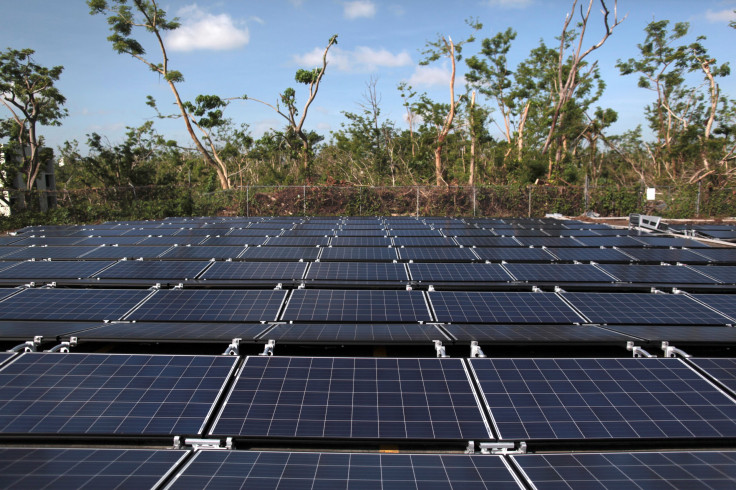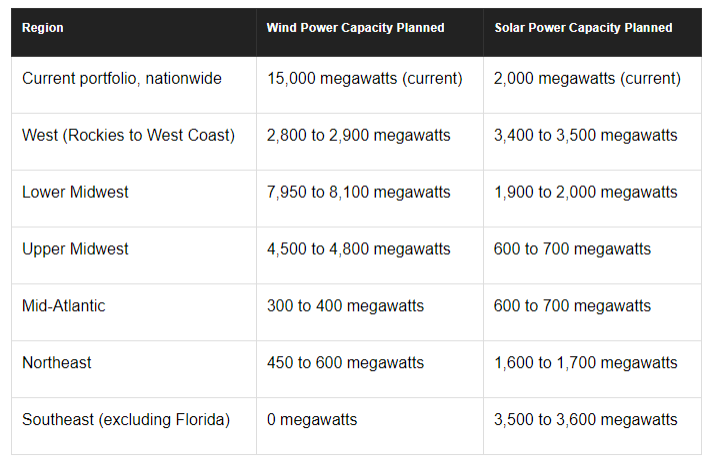America's Renewable Energy Future Isn't Evenly Distributed

The United States generated close to 10% of its total electricity from wind and solar in 2018. The share of modern renewables in the nation's power mix is expected to grow to 13% by 2020 and could reach 30% by 2030. The impressive growth can be attributed to a combination of technological improvements, cost declines, and state policies. But the growth hasn't been evenly distributed.
Thirty-eight percent of America's solar power capacity is installed in California. One-quarter of the country's wind power capacity is spinning in Texas, while 66% is contained within the 11 states in the American Wind Corridor, which runs roughly down the center of the Lower 48. There's a 360,000-square-mile swath of the Southeast, spanning seven whole states, that isn't home to a single wind turbine. And the Eastern Seaboard is furiously building natural-gas pipelines and power plants -- even converting coal-fired power plants to run on gas.
Put another way, wind and solar power potential is heavily influenced by geography, which means national averages can be a little misleading. That's something individual investors have to take into account when crafting a clean-energy investing strategy.
Geography matters. Invest accordingly.
A thermal power plant would deliver roughly the same output if it were built in Texas or New York. The same would not be true for two identical solar or wind farms. That affects everything from the price of electricity to the ambitions of state policies. It's why sun-soaked California can mandate that 100% of its electricity come from renewable sources by 2045 without much trouble, while cloud-covered Pennsylvania will be much more dependent on nuclear power for clean energy.
Generally speaking, the West Coast benefits from bountiful solar, the Midwest thrives from wind-swept plains, and the Eastern Seaboard is praying that offshore wind can help to mitigate its reliance on cheap natural gas. The regional differences in renewable power potential are clearly evident when considering the generation portfolios of NextEra Energy (NYSE:NEE), Xcel Energy (NASDAQ:XEL), and Dominion Energy (NYSE:D).
NextEra Energy produces more electricity from wind and solar than any other company in the world thanks to its power-generation subsidiary NextEra Energy Resources (NEER), which operates 17,000 megawatts of renewable power assets across the country. The company's massive project pipeline highlights how it plans to use geography to its advantage when decarbonizing the nation's regional electric grids.

The long-term pipeline really highlights the poor renewable energy potential of the mid-Atlantic states and the stale air of the Southeast. The latter has actually created a headache for NextEra Energy and its main utility subsidiary, Florida Power & Light (FPL).
Despite being called the Sunshine State, Florida relies on natural gas for 73% of its generation mix, partly due to its lack of wind potential. That led to an outcry from climate-conscious investors that likely tipped the utility's hand to announce an ambitious solar power strategy in which it plans to install 30 million solar panels in the state by 2030 -- representing more installed solar capacity than the entire state boasts today. To be fair, the state's high humidity and salty air corrodes solar panels faster than usual, which also corrodes the economics of the power source, but FPL is determined to find solutions.
Xcel Energy shouldn't have to worry about that problem. The company benefits from owning four electric utilities covering states in the salt-free American Wind Corridor. It's on track to lean on wind and solar for 45% of its power mix by 2027. In fact, it's the only utility in the country to have publicly committed to generating 100% of its electricity from zero-carbon sources by 2050.
What's most impressive about that ambitious goal is the company's confidence it can jettison low-cost natural gas from its portfolio, although that's heavily influenced by geography and intelligent state policies, as its operational territories boast some of the cheapest wind and solar electricity prices in the country.
Dominion Power won't have it so easy. The mid-Atlantic power generator relies on natural gas and coal for 52% of its electricity mix, while renewables contribute just 4%. While the company has come under scrutiny for not being ambitious enough with its long-term plans for clean energy, geography plays a major role in its investing decisions. That means investors can expect natural gas and nuclear power (responsible for the remaining 43% of its power mix) to hold down the portfolio for the foreseeable future, although the company has one trick up its sleeve: offshore wind power.
The United States has just 30 megawatts of offshore wind power capacity operating today, but boasts nearly 24,000 megawatts of projects in planning or development. Nearly all of those dot the Eastern Seaboard, including a potential 2,000-megawatt project being considered by Dominion Energy. If the economics work out from a pilot-stage test phase, then the company could put the massive wind farm into service by 2030.
Your portfolio can't fight geography
Investors eager to add renewable energy growth stocks to their portfolio will have to take into account the regional differences in wind and solar potential from sea to shining sea, especially if more ambitious climate change regulations are handed down by state and federal authorities in the near future. NextEra Energy offers the most complete one-stop shop thanks to its power generation subsidiary, while Xcel Energy's concentrated assets in the American Wind Corridor should help it transition to 100% zero-carbon electricity with relative ease. Dominion Energy and its mid-Atlantic peers won't have it so easy, but it's a stock to watch in offshore wind power, which might represent a significant part of the company's future.
This article originally appeared in the Motley Fool.
Maxx Chatsko has no position in any of the stocks mentioned. The Motley Fool recommends Dominion Energy, Inc and NextEra Energy. The Motley Fool has a disclosure policy.





















